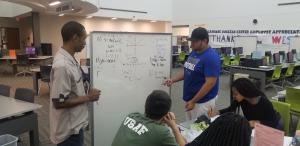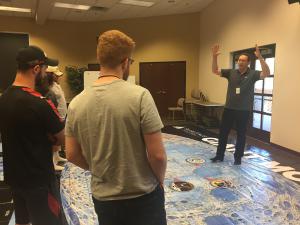Estrella Mountain Community College (EMCC) recently secured another grant that is already changing lives. Ten high school graduates, some of whom had never stepped foot on a college campus before this summer, just completed their first two college courses thanks to the STEM Summer Bridge Grant.
“The grant program is designed to help students get into college during the summer so that they can be more successful when a full semester comes,” said Liahla Roberts, the EMCC STEM Coordinator who wrote the WAESO (Western Alliance for the Expansion of Science Opportunity) subgrant, which was issued by Arizona State University as part of a larger NSF (National Science Foundation) grant. “They’ll know how to navigate the system and they’ll understand the language.”
The grant program, which is geared toward underrepresented students, provided students with free tuition and materials. They took five college credits: Math 151, which is college algebra, and College Preparation for Study, which is a newer course designed to give the students the skill set they need to be successful in college.
The math course is not an easy course and made even more rigorous in a five-week period, but it was chosen for a specific reason.
“If the student decides that he or she does not want to continue on a STEM pathway, this fulfills their math requirement for any other program,” Roberts said. “So it’s not a credit that’s going to be lost to them. It’s something that they can still apply to any of the programs should they choose at the end of this or even in the future.”
The grant program required students to attend mandatory group tutoring sessions.
“They tutor together, so instead of sitting there raising their hands, they complete the homework one problem at a time on a whiteboard, each student taking a turn, and explain how it’s done to each other,” Roberts said. “So they’re able to call on each other and say, ‘No, that’s incorrect, that’s not how I did it,’ and then have that communication so they’re better understanding the material.”
Kylee White, one of the grant recipients, said the group tutoring sessions were extremely helpful.
“My fellow classmates and I would attend tutoring and help each other understand problems that were difficult,” she said. “I enjoyed being in this program because we were more united in a way.”
Those tutoring sessions led to even more group study get-togethers outside of the classroom.
“So it’s definitely grown into what we’re trying to create as this community of learning where you’re surrounding yourself with like-minded or support systems that are going to help you be successful,” Roberts said.
Students also had mandatory STEM interactions of some kind.
“It could be hands-on activities that involve STEM or listening to a STEM guest speaker, somebody who has completed his or her STEM education or has been in the field and is able to tie it back to what it takes to get there,” Roberts said.
The students got that opportunity June 20 when NASA Ambassador Dr. Baron C. Summers, a former EMCC student himself, visited the campus. The cognitive engineering research scientist, who worked as a computer scientist with Boeing for about a decade and conducted research with the Air Force Research Laboratory for about a half a decade, highlighted various space program research projects such as rovers and satellites that the students could work on in their lifetimes. He also shared some of the challenges he faced while working his way through college and doled out some sage advice.
“If you can focus on your studies without having to work, I would do that. And having an idea of where you’re going exactly — what your major is, what kind of career you want — is a good plan because you don’t want to waste time,” he said.
He admitted that he wasn’t sure exactly what he wanted to do when he started taking college classes and took some business classes that didn’t apply to his eventual major.
“If I would have focused on computer science from the beginning, I would have gotten done faster,” he said. “If I had known that I wanted a Ph.D. from the beginning, I would have gotten it much faster.”
The first-generation college graduate started taking classes at EMCC while he was still a sophomore in high school and the campus we know today wasn’t yet built. He transferred to Arizona State University where he received his bachelor’s and then went on to get his master’s and Ph.D.
“If you go to graduate school, consider different disciplines,” he advised. “It gives you greater diversity of thought, bigger awareness. It gives you more skills that can be in demand.”
Kylee said listening to Summers helped her realize that there is always another step or level of education she can achieve and that it’s OK to go for your dreams.
“Hearing how the ambassador wasn’t in a good situation at the time but still continued to get his degrees was amazing,” she said.
The highly successful program led all but one of the students who moved out of the area to sign up for fall classes at EMCC. Some even applied for the Presidential Scholarship, which covers two years of tuition up to 15 credits per semester. Roberts said, unfortunately, many high school students aren’t aware that they qualify for the scholarship or financial aid that can make it possible for them to attend school full time without having to hold down a job.
“There’s a lot of misconceptions I was hoping to break with this program,” Roberts said.
She has succeeded beyond her wildest dreams as the students have not only transcended their own expectations but have also given their family members something to strive for.
“By the end of the orientation, which the students’ families were invited to, some of the parents were even asking, ‘How do I enroll?’” Roberts said. “That was huge to include them. Now, they are more supportive at home because they shared in the experience.”

